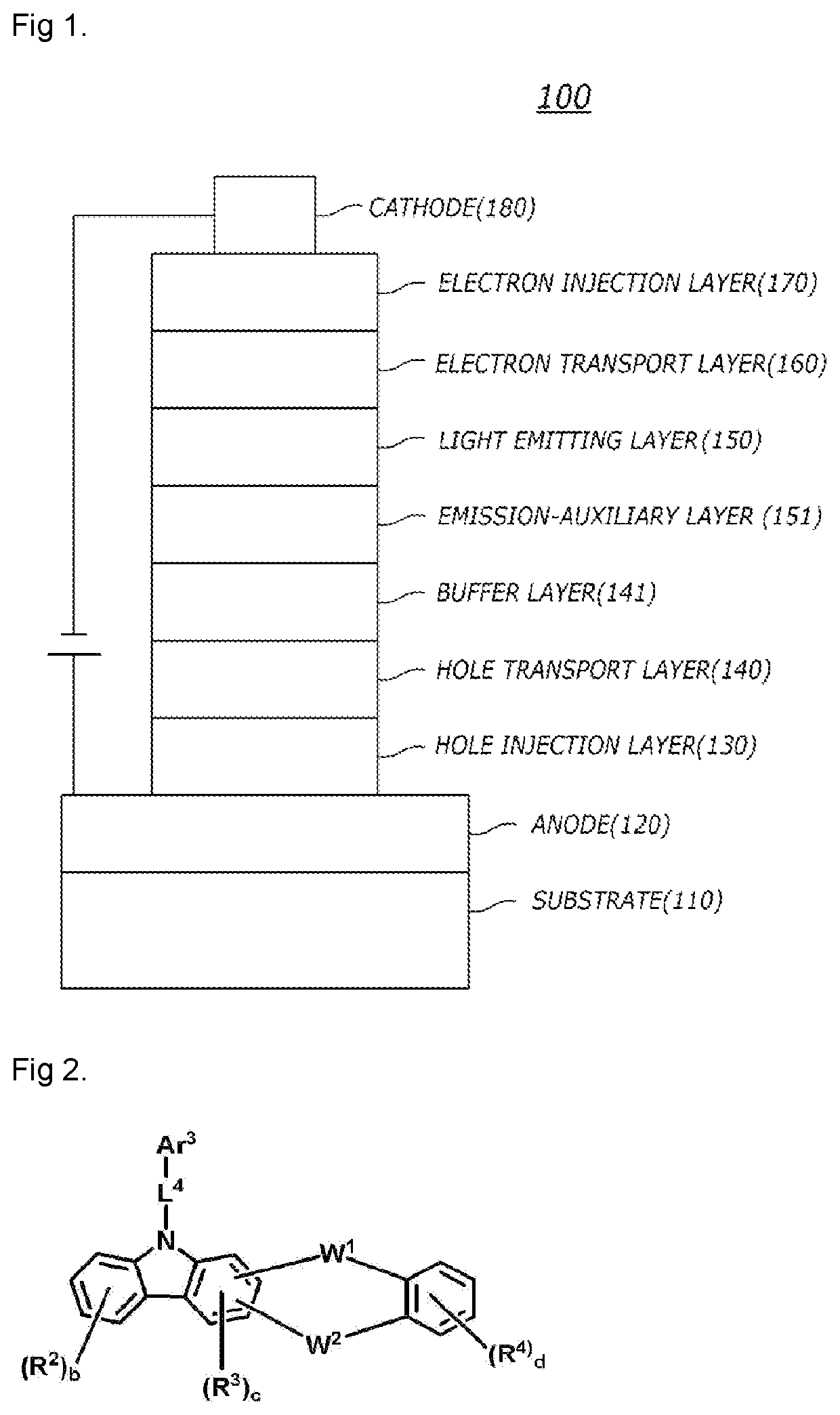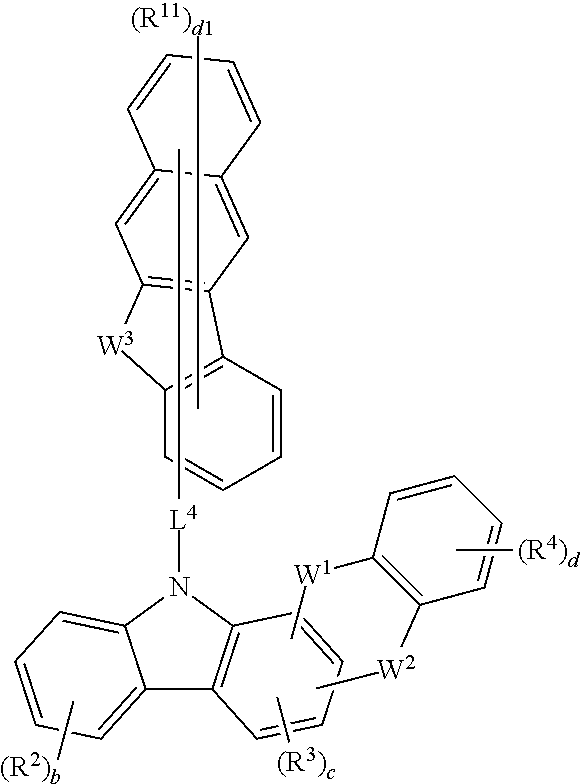Compound for organic electric element, organic electric element using the same, and an electronic device thereof
a technology of organic electric elements and organic electric elements, which is applied in the direction of organic chemistry, solid-state devices, semiconductor devices, etc., can solve the problems of reducing the efficiency of corresponding elements, reducing the luminous efficiency, and shifting the maximum luminescence wavelength to a longer wavelength, so as to improve the luminous efficiency and lifetime of elements, the effect of lowering the driving voltage and reducing the driving voltag
- Summary
- Abstract
- Description
- Claims
- Application Information
AI Technical Summary
Benefits of technology
Problems solved by technology
Method used
Image
Examples
synthesis example 1
[SYNTHESIS EXAMPLE 1] Formula 1
[0118]The compound represented by Formula 1 according to the present invention can be synthesized by reacting Sub 1 and Sub 2 as shown in Reaction Scheme 1, but there is no limitation thereto.
1. Exemplary Compounds and Synthesis Examples of Sub 1
[0119]Compounds belong to Sub 1 of Reaction Scheme 1 are as follows, but there is no limitation thereto.
[0120]FD-MS (Field Desorption-Mass Spectrometry) values of compounds belong to Sub 1 are shown in Table 1 below.
TABLE 1CompoundFD-MSCompoundFD-MSSub 1-1m / z = 344.16(C22H21BO3 = 344.22)Sub 1-2m / z = 344.16(C22H21BO3 = 344.22)Sub 1-3m / z = 344.16(C22H21BO3 = 344.22)Sub 1-4m / z = 344.16(C22H21BO3 = 344.22)Sub 1-5m / z = 470.21(C32H27BO3 = 470.38)Sub 1-6m / z = 344.16(C22H21BO3 = 344.22)Sub 1-7m / z = 344.16(C22H21BO3 = 344.22)Sub 1-8m / z = 344.16(C22H21BO3 = 344.22)Sub 1-9m / z = 344.16(C22H21BO3 = 344.22)Sub 1-10m / z = 344.16(C22H21BO3 = 344.22)Sub 1-11m / z = 344.16(C22H21BO3 = 344.22)Sub 1-12m / z = 520.22(C36H29BO3 = 520.44)...
synthesis example 2
[Synthesis Example 2] Formula 2
[0173]The compound (Final product 2) represented by Formula 2 of the present invention may be prepared by reacting Sub 3 and Sub 4 as shown in Reaction Scheme 4 below, but is not limited thereto.
1. Exemplary Compounds and Synthesis Examples of Sub 3
[0174]The compounds belonging to Sub 3 of Reaction Scheme 4 are as follows, but are not limited thereto.
[0175]The FD-MS values of the compounds belonging to Sub 3 are shown in Table 4 below.
TABLE 4CompoundFD-MSCompoundFD-MSSub 3-1m / z = 332.13(C24H16N2 = 332.41)Sub 3-2m / z = 273.06(C18H11NS = 273.35)Sub 3-3m / z = 257.08(C18H11NO = 257.29)Sub 3-4m / z = 283.14(C21H17N = 283.37)Sub 3-5m / z = 257.08(C18H11NO = 257.29)Sub 3-6m / z = 283.14(C21H17N = 283.37)Sub 3-7m / z = 332.13(C24H16N2 = 332.41)Sub 3-8m / z = 273.06(C18H11NS = 273.35)Sub 3-9m / z = 257.08(C18H11NO = 257.29)Sub 3-10m / z = 283.14(C21H17N = 283.37)Sub 3-11m / z = 332.13(C24H16N2 = 332.41)Sub 3-12m / z = 332.13(C24H16N2 = 332.41)Sub 3-13m / z = 257.08(C18H11NO = 257.29...
synthesis example
of 2-129
[0226]
[0227]Sub 3-7 (65 g, 195.54 mmol) was dissolved in toluene (950 mL) and Sub 4-66 (58.11 g, 195.54 mmol), Pd2(dba)3 (5.37 g, 5.87 mmol), P(t-Bu)3 (39.56 g, 195.54 mmol), NaOt-Bu (37.59 g, 391.08 mmol) were added to the solution. Then, the reaction was carried out in the same manner as in the synthesis method of 2-36 to obtain 85.83 g (yield: 80%) of the product 2-129.
[0228]The FD-MS values of the compounds 2-1 to 2-166 of the present invention synthesized by the above synthesis method are shown in Table 6 below.
TABLE 6CompoundFD-MSCompoundFD-MS2-1m / z = 408.16(C30H20N2 = 408.5)2-2m / z = 435.17(C31H21N3 = 435.53)2-3m / z = 410.15(C28H18N4 = 410.48)2-4m / z = 536.2(C38H24N4 = 536.64)2-5m / z = 586.22(C42H26N4 = 586.7)2-6m / z = 536.2(C38H24N4 = 536.64)2-7m / z = 563.21(C39H25N5 = 563.66)2-8m / z = 592.17(C40H24N4S = 592.72)2-9m / z = 491.15(C33H21N3S = 491.61)2-10m / z = 527.15(C36H21N3S = 527.65)2-11m / z = 533.1(C34H19N3S2 = 533.67)2-12m / z = 580.17(C39H24N4S = 580.71)2-13m / z = 504.14(C33H2...
PUM
| Property | Measurement | Unit |
|---|---|---|
| thickness | aaaaa | aaaaa |
| thickness | aaaaa | aaaaa |
| thickness | aaaaa | aaaaa |
Abstract
Description
Claims
Application Information
 Login to View More
Login to View More - R&D
- Intellectual Property
- Life Sciences
- Materials
- Tech Scout
- Unparalleled Data Quality
- Higher Quality Content
- 60% Fewer Hallucinations
Browse by: Latest US Patents, China's latest patents, Technical Efficacy Thesaurus, Application Domain, Technology Topic, Popular Technical Reports.
© 2025 PatSnap. All rights reserved.Legal|Privacy policy|Modern Slavery Act Transparency Statement|Sitemap|About US| Contact US: help@patsnap.com



